Pros
Cons
Introduction
We were lucky enough to get early access to the full version of the game prior to its official release, and can tell you that Deadlight is all of the aforementioned, and a whole lot more. Slick gameplay, relentless puzzles, and a compelling cinematic atmosphere are juggled atop the frenzied fallout of a world torn apart.
If you took the brutal memorization and quick reflexes required by Sonic the Hedgehog, the character interaction and depth of atmosphere found in Oddworld, the unfortunate acting of The Walking Dead (TV series), and threw in just a pinch of Limbo, you might have something akin to Deadlight. Oh, and it's chock full of faux 80s memorabilia, secret areas, and odd little handheld game-within-game pickups.
Sound a little hard to sum up? It is. The game feels, at times, a little confused about whether it's an underdeveloped full release or an overdeveloped arcade release. But as hard as it is to describe, it's just as hard to stop playing: Xbox Live Gold members will discover this in just a couple of days.
This review was written after playing and completing a full version of Deadlight. Completion took roughly 3 hours of recorded gameplay, but including the extra time added by deaths and being stumped by puzzles, is closer to 6 or 7 hours.
Video Review
{{section_header}}{{section.name}}{{/section_header}}
Gameplay Overview
{{section_header}}{{section.name}}{{/section_header}}
{{photo_gallery "Gameplay Overview Photos"}}
In Deadlight, you play Canadian ranger Randall Wayne. His friends call him Randy. Randy's sole goal is a modern supplement of numerous contemporary forms of zombie media: his wife and daughter are missing, and he's got to get to Seattle to find them. His only clue is that they're likely in a mysterious Safe Zone, somewhere in the city.
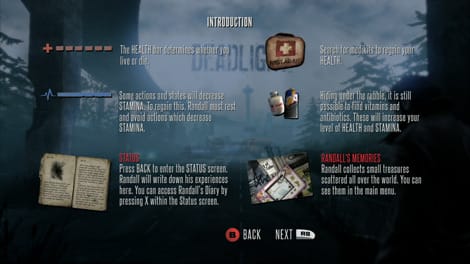
Despite that his occupation requires him to ward off poachers and put down rabid foxes, Randy is surprisingly well equipped to deal with the Shadows--human beings infected with a mysterious, possibly man-made virus that causes them to become agitated, volatile, unable to speak, braaains... you get the picture. Randy must run, shove, hack, shoot, leap, crawl, solve, and hide his way past the Shadows on his way to, and through, Seattle.
Platforms: Friend and Foe
Combat: Fight or Flight
{{section_header}}{{section.name}}{{/section_header}}
{{photo_gallery "Gameplay Part 2 Photos"}}
What kind of survival horror game would Deadlight be if you could just run and jump away from all your problems? Randy is a ranger, after all, and when the going gets tough, he gets tougher. The game is still, primarily, a platformer, but sometimes you've just gotta show those Shadows who's boss. (Hint: it's you)
There are two kinds of combat in Deadlight: melee, and ranged. Randy finds a fireman's axe pretty early on in his trek towards Seattle, and soon discovers that it's useful for breaking through padlocked gates, chopping through boarded-up windows, and hacking Shadows right out of existence.
In a similar vein to another recent XBLA title, I Am Alive, Deadlight makes use of a stamina bar that dictates how much "doing power" Randy has to work with. It drains a little during jumps, and drains over time during climbing sections, but is most important to keep an eye on during your axe-centric melee combat. A few swings at a Shadow will usually knock it down, and a big arcing chop will put an end to its violent behavior. But too much of swinging an axe around can tire out even the hardiest Canadian ranger, and extended lengths of melee combat will drain your stamina, causing you to move and swing slower, breathe heavily, and become much less agile for a short time.
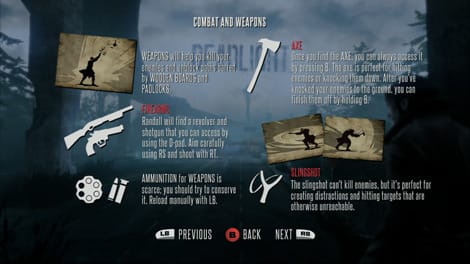
It's for this reason that picking your battles wisely is such an integral part of the combat in Deadlight. It may be true that killing zombies absolutely requires firearms in this day and age, and make no mistake, there are a couple more fatal friends to add to your arsenal before the game is done. But even with a gun in tow, ammo is sparse, and the Shadows are not.
If it seems like there are only a couple of zombies in an area, there's nothing wrong with going for a headshot or taking the time to knock them down and show them what you learned in fireman school. They're called Shadows for a reason, though, and alerting just one zombie can sometimes draw two or three from the umbric depths of the crumbling street, leaving you to make a decision: fight or flight?
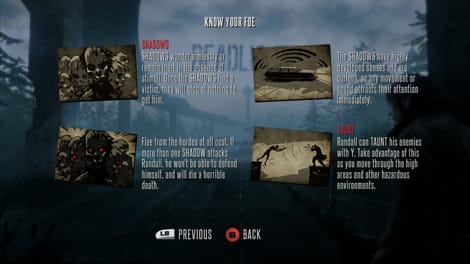
You could simply cap them all; after all, a single well-placed shot to the head will put a Shadow down for good. But what if you miss? Aiming, reloading, and shooting take time and precision, and you only have so much ammo per any given section of the game. Sometimes it's best to simply run away, or get up onto a nearby car where you can take your time aiming to make the most of your bullets.
A big catalyst of the tension in deciding whether to stay and fight or run away depends entirely on how methodical you want to be; often, areas contain secret pick-ups, extra ammunition, or scraps from Randy's journal. We can tell you first hand, if you run away from every fight, you're going to miss a lot of things.
Puzzle's Progress
{{section_header}}{{section.name}}{{/section_header}}
{{photo_gallery "Gameplay Part 3 Photos"}}
In our estimation, about 50% of Deadlight is a mix of exploration and combat, or moving from point A to point B in order to complete a short term goal (which is always, in some way, tied to your long term goal). The other 50% is navigating through shrewdly disguised puzzles, worked in so that you'll be halfway through one before you realize you're no longer in an exploration section. We call them disguised, but the game is very clearly broken up into sections of exploring, fleeing, and working through a puzzle area, varying the tempo between medium (exploring), fast (fleeing), and slower (puzzling).
The game is divided into three Acts. The first Act serves as a decent introduction to the three gameplay elements--platform, combat, and puzzle challenges. The second Act is given almost entirely to increasingly more difficult puzzles: without going into too much detail, we can say that a lot of the focus is taken off of combat for the majority of Act 2, with some exceptions, giving the developers a chance to delve more completely into the puzzle-platform side of the game.
Our only gripe with the puzzles in Deadlight is the spot-on accuracy they occasionally require. Randall may be a ranger, but he isn't Spider-Man. He's got a bag of tools, a trenchcoat, heavy boots, and potentially a firearm or two at any given moment, not to mention that hefty fireman's axe from the beginning of the game. When he takes a big jump, he tends to slide around, and when you're leaping to a platform that only gives a foot of real estate to either side of your landing zone... let's just say it can get frustrating to watch him slide off and fall to his death, and have to restart through an earlier section of the puzzle that's much more slowly paced.
For the most part, the puzzles are fairly easy, but the platforming elements required to complete them are fun, and because of the game's unique cinematic visuals, are a treat to watch (at least the first four times). We can guarantee a couple of experiences for most gamers: you will, at some point, find yourself wondering how a puzzle could be so easy. And at some point, you'll be shutting the game off in frustration because the physics are too precise for the character forced to abide by them.
Controls
{{section_header}}{{section.name}}{{/section_header}}
{{photo_gallery "Controls Photos"}}
Deadlight, in the sense of a game, is a very precise world where each challenge contains a "hole in one" element. There is a way to do it perfectly. But Randall Wayne is not perfect, as players will discover after getting through the initial opening of the game.
The controls map well to the Xbox 360 controller. There are some traditional button functions that will be immediately intuitive to veteran gamers. You can walk by gently tilting the control stick, or take a steady Gears of War style jog by tilting it completely. Because the game is of the 2D, side scrolling bent, you only ever have to decide to go left, right, up, or down, all of which is handled by the left analog stick.

Holding RB while moving will send Randy into a sprint. There are sections of the game where you must sprint for a long time, watching your stamina bar carefully, occasionally sliding to a clumsy stop in order to hack some Shadows out of the way and vault through a nearby window. Jumping is handled with the A button, and melee combat (shoving/the fireman's axe) is all done with the B button. Randy can make big jumps if he sprints before jumping.
Picking up ammunition, secrets, pages of Randy's journal, First-Aid kits, and any sort of world interaction is mapped to the X button. The Y button is used to "taunt" the Shadows into moving towards you, which can be used as a way to group them together for a killing blow, to leap away to safety over their heads, or to lead them stumbling into some fatal trap, like a live wire from a snapped electrical cord.
Ranged gunplay is handled on its own system. The right analog stick allows Randy to aim his .38 revolver in a 360° arc, with a small red reticule and a line-of-sight marker showing the trajectory and target of the bullet. Pulling out your weapon will disable the ability to sprint away for a moment, and Randy must hand-load each bullet one at a time (using the LB button) before he can fire off a full barrel.
Finally, if you want to sneak around like Sam Fisher, you can hold LT to crouch and move more slowly. This allows Randy to creep through tunnels and air ducts, or sneak under busted loading bay doors. Tapping LT during a sprint will launch Randy into a rolling dive, and holding LT during a long fall will cause Randy to roll as he hits the ground, avoiding damage. Note that there's no stealth element to the game; you can't really sneak around like the Fish-man.
Replay Value
{{section_header}}{{section.name}}{{/section_header}}
{{photo_gallery "Replay Value Photos"}}
We'd have to bargain that most players will only play through Deadlight once. There's only one difficulty, and once you've built up your skills to deal with the various challenges thrown at you in Act 3, Act 1 seems like child's play. If you wanted to get all the achievements, you might have to play through the game again, but the "scene select" function means you can jump into scenes or acts that you missed things in, which wouldn't require a second full run of the game.
Additional Content
{{section_header}}{{section.name}}{{/section_header}}
{{photo_gallery "Additional Content Photos"}}
While it's definitely too early to predict any DLC, we'd reckon there might be some additionally released content should fan response demand it. The game, as of right now, has 30 unlockable Achievements worth a total of 300 G. (Oddly enough, they're all named after 80s songs...)
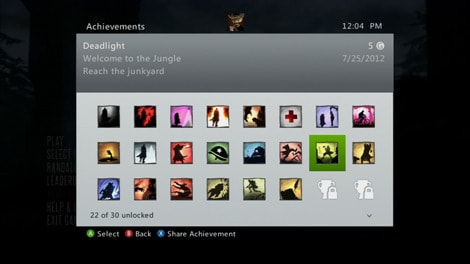
There are a large number of secret pick-ups to be found throughout the game, three of which are minigames that you can play from the main menu, all fake 80s-style handhelds, with one to be found in each Act. During our playthrough, we found the first one, but were too desperate later in the game to locate the others.
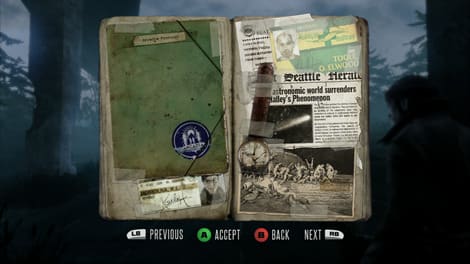
Your pick-ups range from random memorabilia, to I.D. cards, to health and stamina upgrades, to pages of Randy's journal. If you want to find everything, you're going to have to do a lot more Shadow slaying than you would otherwise, but the boosts to your health/stamina and the extra insight into the story make it worthwhile.
There are also, of course, a few avatar awards and gamerpics to unlock.
Pacing & Flow
{{section_header}}{{section.name}}{{/section_header}}
{{photo_gallery "Pacing & Flow Photos"}}
One of the biggest issues we had with Deadlight was that, unlike most games, it absolutely does not hold your hand. Most of the time, this was welcome. But every now and then, it led to a severe annoyance.
There are events throughout the game that lead you to expect certain weapons/items to function in a particular manner, and occasionally, those expectations will be completely thwarted.
Combat, puzzles, and platforming get progressively more difficult as you get further in Deadlight. The game does little to warn or tell you that you've graduated from one "grade" of difficulty to another, and sometimes after plodding along without trouble for a while you'll be met with a section that will make you say, "Wow, this just got serious."
The waxing/waning difficulty and mix of play pacing has a lot to do with individual skill, but it does lend itself to a sense of desperation and realism. It's somewhere on the other side of the spectrum from having an infinite ammo rocket launcher in Resident Evil 5.
AI
{{section_header}}{{section.name}}{{/section_header}}
{{photo_gallery "AI Photos"}}
There's not a lot of friendly AI to be found in Deadlight. It's a very solitary experience, and most of the things you meet want to kill you. That said, the Shadows may be stupid enough to run off of buildings or into a patch of electricity, but they can be very threatening in groups. A Shadow that gets too close to Randy will grab him, and the player must mash the B button to free himself, all the while still taking damage from any surrounding Shadows. If you get away from this encounter, consider yourself very lucky. 9 times out of 10, you're going to die.
The difficulty of the Shadow AI comes primarily from the game's 2D orientation. Shadows who are in the background cannot be shoved, chopped, or shot, but will track you as they head for the foreground, often popping into combat range only once they're right on top of you. This can be very frustrating, and it makes for a tense situation when you're fending off zombies to the left and right, while any number more are coming from somewhere in the background.
Storytelling Overview
{{section_header}}{{section.name}}{{/section_header}}
{{photo_gallery "Storytelling Overview Photos"}}
We think playing the game tells the story of Randall Wayne the best, though players have the option to read through Randy's diary before ever starting the game, and it gives a lot of his back story, and leads right up to the opening cinematic. We highly recommend doing so.
It's clear from a cursory reading of Randy's diary that something is a little "off" about him. He doesn't seem to like people very much, and is a strange mix of anti-Commie patriot and nature-loving woodsman. The opening cinematic reveals his cold exterior quite readily, as he's forced to sacrifice a friend who has been recently bitten and maimed by a Shadow.
The game is sprinkled by story cinematics that are hand-drawn in a comic book style. We think the real time game looks much better, and we often felt alienated by the mildly stylized comic-style cinematics that were peppered between gameplay segments. Still, they're a good way to illustrate the reason the game has an M Rating.
The writing and voice acting are leagues behind the game's visual, artistic presentation and musical score. Not only are there numerous typos and weird run-on sentences in the menus and Randy's diary, but the voice acting on most of the characters besides Randy seems rushed and poorly executed.
Writing
{{section_header}}{{section.name}}{{/section_header}}
{{photo_gallery "Writing Photos"}}
The story behind Deadlight, taken abstractly, is a fairly interesting look at the impact of human decisions, the fragility and strength of the human psyche, and the importance of learning from your mistakes, wrapped up into a hot zombie panini. It's a humorless, serious romp, with one redeeming character (Randy) surrounded by characters who are either expendable or mostly forgettable.
Randy's diary has been fashioned to appear hand-written, and to represent his various mental states, both before and during his trek to/through Seattle. The writing and spelling is sometimes off, and we're not sure if this is meant to represent his level of education, or was simply a lack of editing by Tequila Works. There is one very obvious typo in the options menu, and we know that wasn't stylization.

The in-game dialogue is decent at best, and at worst is fairly unbearable. Some of things Randy says (he talks to himself a lot) are poignant, and some are just trying really hard to be poignant. Overall, though, the writing is suitable to the game.
Acting
{{section_header}}{{section.name}}{{/section_header}}
{{photo_gallery "Acting Photos"}}
The in-game characters are very realistic and believable. Though you don't see many other human beings, the shuffling, half-walk half-run of the Shadows is convincing and eerie. Suitably, the most attention has been given to Randy, and his movements during walking, running, sprinting, and panting to catch his breath are very threshed out and realistic. As we said, the actual game play is, on a whole, gorgeous and believable. The comic cinematics, not so much.
A lot of improvement could be made to the voice acting segments. The characters don't always say the same thing as the on-screen captions, sometimes missing entire words, and when they do, it feels either too underwhelmed by the current (horrifying) situation, or entirely too freaked out. We understand that bad acting is sort of a formula standby for zombie media, but it doesn't really add to a game that seems to take itself so seriously in all other arenas.
Cinematics
{{section_header}}{{section.name}}{{/section_header}}
{{photo_gallery "Cinematics Photos"}}
Deadlight is peppered by drawn, comic style cut scenes with approximations of movement and action, overlaid by sub-par voice acting. The game itself is a gorgeous, shadow-rich environment full of tiny details and well-wrought vistas. The cinematics, by contrast, are stark and minimalist, usually only populated by one color (the gore kind). We felt put off by these comic book-style cut aways, and were eager to get back into the game whenever one of them popped up.
Graphics & Atmosphere Overview
{{section_header}}{{section.name}}{{/section_header}}
{{photo_gallery "Graphics & Atmosphere Overview Photos"}}
The world of Deadlight is a ruptured wound, with the infected pouring forth and the last hope for survival quickly becoming a pipe dream in the aftermath of the chaos. Randall Wayne must find his wife Shannon and daughter Lydia, but has only a vague idea of how to get to them. Along the way, he traverses dangerous city streets, crumbling buildings, water-rusted sewers, and at least one bullet-peppered military shelter turned warzone. The music trills idly in the background as you wander, rising to a panicked clash whenever the horde bursts forth. Each scene and moment is cemented by a dark, detailed and shadow-heavy visual that is as rewarding to look at as it is to play in. While the story and especially the voice acting are just barely hitting par, the graphical design of the game is nigh flawless.
Art Design
{{section_header}}{{section.name}}{{/section_header}}
{{photo_gallery "Art Design Photos"}}
Perhaps what makes Deadlight stand out the most, in passing memory at least, is its visual presentation. While a deserted city, crumbling and still, is nothing new in a market that's quite saturated with zombie/survival horror genre games, the scenes in Deadlight are still very memorable and unique. The heavy use of shadow tones and muted colors make shafts of sunlight or colored areas look even more vivid and inviting, giving a glimpse of hope for Randall to find his family.
Graphics
{{section_header}}{{section.name}}{{/section_header}}
{{photo_gallery "Graphics Photos"}}
Graphically, Deadlight is no power house. Certain character animations and environment interactions look forced, and at worst, don't happen the way they were meant to. A scrupulous study of the graphical quality would likely reveal a number of less-than-perfect mesh and edge textures. Interactive objects glow with a faint blue-purple light, which (on certain TV sets) tends to blend into a blurry mess that's very distracting. But the pacing of the game allows for a sense of depth and detail, with puzzle sections featuring plenty to look at, and fleeing sections being trimmed to the essentials. The graphics are fairly good, and serve to at least not detract from the game's art design.
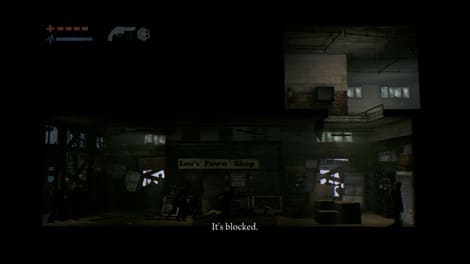
Music
{{section_header}}{{section.name}}{{/section_header}}
{{photo_gallery "Music Photos"}}
The music in Deadlight seems to inhabit one of two niche categories: either a haunting, string-laden choir track that signifies a sense of hopelessness and loss, or something more upbeat and edgy, pumping along in the background as Randy attempts to flee into the confines of safety. The music works well, though it definitely takes a back seat to the game's stunning artistic presentation. Overall, it neither detracts nor supplements the game too heavily.
Sound Effects
{{section_header}}{{section.name}}{{/section_header}}
{{photo_gallery "Sound Effects Photos"}}
The sound of the clamoring Shadows as they note your presence, Randy's grunts of effort as he hauls himself over an upturned ambulance, and the kickback blast of the shotgun you find late in the game all serve to add to a sense of realistic coherence in Deadlight. Unfortunately, a lot of character dialogue--we won't say exactly what, to avoid excessive spoiling--is repeated over and over. This can be terribly annoying when you're restarting a section after dying a few times. Randy likes to talk to himself, and reloading into the same monologue the third or fourth time is borderline obnoxious.
Conclusion
Deadlight is a game that was made with a lot of freedom, and a lot of love. It feels handcrafted, for better or for worse.
We finished the campaign, with a total of 85% completion, and 22 of 30 Achievements unlocked, in just under 3 hours. But that's recorded play time from checkpoint to checkpoint. The actual time spent finishing the game was somewhere between 6 and 7 hours. That's a decent chunk of gameplay for a game that only costs $9.99 (800 Microsoft Points).
There are three Acts in Deadlight, split into many more scenes. We played up to the beginning of Act 3 in one sitting before tearing ourselves away from the game. The mix of narrative, flashback, action, puzzles, and platforming, strewn across a beautifully rendered 2D environment, is a winning combination, and anyone who likes 2D side scrollers, zombies, or visually compelling art should take note.
While there are parts of the game that feel unfinished and somewhat raw, it's a great step in the right direction for Tequila Works, and is worth the cost of admission. Between the length of the campaign, the rewarding gameplay, the collectibles and achievements, and the haunting twist that the game concludes with, we'll be thinking about Deadlight for the next few weeks, despite having already finished it.
Expect Deadlight on August 1st, 2012. And when Randall says "run," don't hesitate.
Photo Gallery
{{photo_gallery "Gameplay Overview Photos", "Gameplay Part 1 Photos", "Gameplay Part 2 Photos", "Gameplay Part 3 Photos", "Gameplay Part 4 Photos", "Gameplay Part 5 Photos", "Gameplay Part 6 Photos", "Gameplay Part 7 Photos", "Gameplay Part 8 Photos", "Controls Photos", "Replay Value Photos", "Additional Content Photos", "Pacing & Flow Photos", "AI Photos", "Storytelling Overview Photos", "Writing Photos", "Plot & Player Choices Photos", "Acting Photos", "Cinematics Photos", "Graphics & Atmosphere Overview Art Photos", "Art Design Photos", "Graphics Photos", "Music Photos", "Sound Effects Photos", "Multiplayer Overview Photos", "Competitive Multiplayer Photos", "Co-Op Multiplayer Photos", "Game Modes Photos", "Customizability Photos", "Matchmaking Photos", "Community Features Photos"}}
Meet the tester
Lee was Reviewed's point person for most television and home theater products from 2012 until early 2022. Lee received Level II certification in TV calibration from the Imaging Science Foundation in 2013. As Editor of the Home Theater vertical, Lee oversaw reviews of TVs, monitors, soundbars, and Bluetooth speakers. He also reviewed headphones, and has a background in music performance.
Checking our work.
Our team is here to help you buy the best stuff and love what you own. Our writers, editors, and experts obsess over the products we cover to make sure you're confident and satisfied. Have a different opinion about something we recommend? Email us and we'll compare notes.
Shoot us an email

